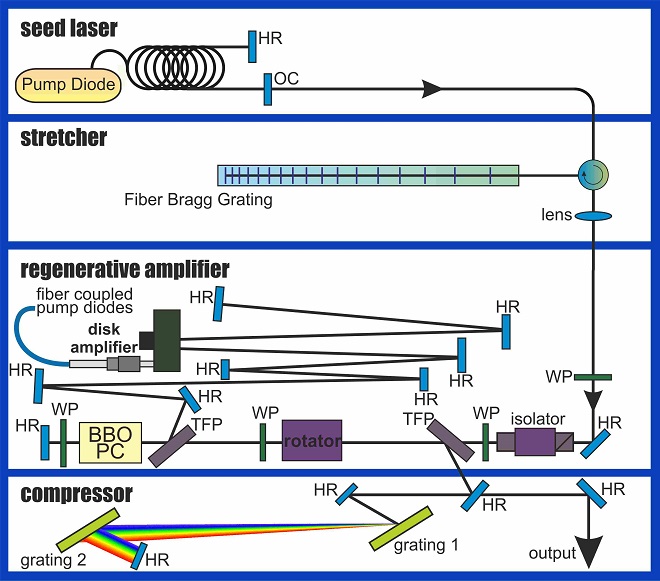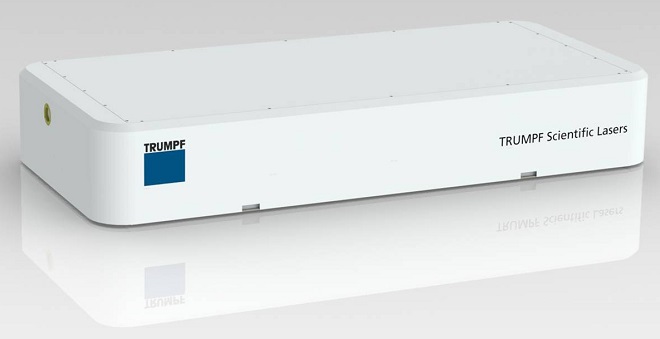Ditzingen/Munich, January 31, 2014. What if you could watch molecules forming and make the movement of electrons visible? In medicine, biology and chemistry, the potential would be huge – just imagine being able to design exactly how a medicine acts at the atomic level. Taking it to the next stage, we would be able to break atomic bonds and determine the movement of electrons – made-to-measure and tailor molecules, if you like. And in the future, innovative X-ray sources would allow tumors to be identified and treated right when they first appear. What seems like a far-off science fiction fantasy is actually closer than you might think. To realize the first step – to observe – all you need is a camera fast enough to capture these processes at their actual speed, counted in attoseconds. Such a camera can be based on beam sources that emit short pulses of light of precisely this attosecond duration. Generating these attosecond pulses and working on the wide range of possible applications they offer has become an established part of research laboratory work.

Scheme of the regenerative amplifier built by TRUMPF Scientific Lasers.
To generate the attosecond pulses, high-energy laser pulses with a duration of a few femtoseconds – which are known as few-cycle laser pulses – are focused into an noble gas beam within a vacuum chamber. The strength of the laser pulses’ electric field allows to set the electrons of the noble gass free and accelerates them away from the nucleus. At this point, the electrons reach speeds of tens of thousands of kilometers per second. But in the very next half oscillation of the laser pulses´ electromagnetic field, by which time the electrons have managed to travel only a few nanometers, they are driven back toward the atom nucleus. This can lead to recollision, where electrons release all the energy they have acquired during their journey enforced by the laser field as an attosecond pulse. These pulses are coherent extreme ultraviolet rays. Generating isolated attosecond pulses can be achieved only by making use of high-energy few-cycle pulses – and until now there have been hardly any such beam sources available on the market.
This is where TRUMPF Scientific Lasers comes in. The joint venture between laser manufacturer TRUMPF and ultrashort pulsed laser expert Professor Ferenc Krausz brings together basic research and industrial ultrashort pulselaser expertise in an effort to develop efficient beam sources for generating attosecond pulses. To be more precise, what is being worked on is an optical-parametric chirped pulse amplification (OPCPA) system. This involves using an ultrashort seed pulse from a titanium sapphire oscillator and then amplifying it in several stages to reach the peak pulse power needed to generate attosecond pulses. The seed pulse has a duration of a few femtoseconds and an ultrabroad wavelength spectrum. However, at just a few nanojoules it has insufficient pulse energy.
To supply seed pulses with the necessary energy, a part of them is overlaid with high-energy but narrowband pulses from a laser amplifier within a suitable, non-linear crystal. This laser amplifier or so-called pump laser takes the form of a disk-based regenerative amplifier based on TRUMPF’s TruMicro series 5000. Afterwards, the amplified pump pulses reach pulse energies of tens of millijoules at a pulse duration between one or two picoseconds. In the next step of the process, the seed and pump pulses are overlapped in an optical-parametric amplifier (OPA). Here, the specific characteristics of seed pulse and pump pulse are combined: the shortness and bandwidth of the seed pulses and the high pulse energy of the pump pulses.
It is highly important to synchronize the overlap between the pulses since within the parametric amplifier energy can be only transferred from the pump to the seed pulses when they overlap in time and space. Experts from TRUMPF Scientific Lasers came up with a synchronization concept that guarantees both pulses meet at exactly the right time, thereby assuring a stable and reliable beam source.
The advantage of the parametric amplifier concept is that energy is transferred directly to the seed pulse without heat being generated in the crystal. What is more, the seed pulses retain almost their entire spectral bandwidth, which makes it possible to generate laser pulses that are both highly-energetic and ultrashort. Since the decisive factor in scaling up energy using an OPCPA system is the pump energy available, disk-based regenerative amplifiers are extremely suited to use as pump sources in these systems.
In May 2013, the Munich-based laser experts presented this pump source at the Laser World of Photonics. Their source provides considerable pulse energy – up to 50 millijoules – as well as mean power of up to 300 watts and a peak pulse power of up to 50 gigawatts. This pump laser already could amplify few-cycle pulses beyond 20 watts in the near infrared and exceeds any existing few-cycle technologies by one order of magnitude. With this system, both pulse energy and average power are also entirely scalable, meaning that they can be individually tailored to fit the requirements of the task at hand. The system is capable of providing repetition rates ranging from one kilohertz to one megahertz. Current TRUMPF disk technology allows for pump lasers with an energy of up to two joules.
By employing the new pump source and cascading numerous stages of amplification, this means that in future TRUMPF Scientific Lasers will be able to achieve peak pulse powers of some terawatts at a pulse duration of just a few femtoseconds. This provides a unique foundation for generating attosecond pulses in an extremely compact and efficient way. An initial OPCPA system is currently under construction, while work is also continuing on the development of the regenerative amplifier. Laser energies of up to 200 millijoules are expected by the spring of 2014.












